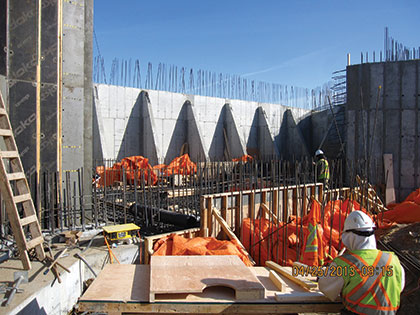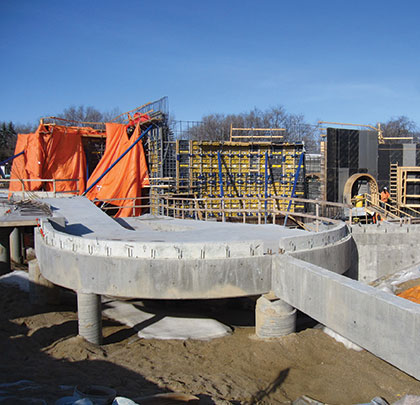Located in the Assiniboine Park Zoo in Winnipeg, Manitoba, Canada, the Journey to Churchill exhibit located in the 11-acre Arctic Animal area began in April 2012. With the goal of profiling the Churchill Manitoba area and the interesting flora and fauna common to the region, Stuart Olson Dominion Construction Ltd. chose Doka formwork systems and engineering services to help construct the $50-million project.
Although teamwork is key to any construction project, this one required working closely with biologists and habitat specialists to accomplish the goal. Further, aside from usual site safety protocol, this is an active zoo with lions and tigers open to the public, so steps had to be taken to protect the visitors, the workers, and the existing animal population.
FORMING WITH VERSATILITY
The owner sought to recreate arctic and subarctic tundra conditions accurately enough to look like the real thing. Concrete was the obvious material of choice because of its minimal maintenance and ability to withstand the harsh environment. As such, the project involved construction of several structures, some with large concrete saltwater tanks with walk-through viewing for the polar bear and seal. There are viewing stands to watch tundra animals, such as caribou and musk ox, with high concrete walls to facilitate building shotcrete rock structures as backdrops.
Doka’s versatility and experience enabled the contractor to meet a variety of forming requirements. Doka supplied framed wall formwork, Frami for two main elements on this project, which was light enough to be used as a handset, yet could be ganged where appropriate. The barrier walls constructed were required to stop animals from escaping, and filtration tanks were used for the processing of the sea water required to maintain proper levels of salt water for seals and aquatic creatures.

Main Photo: To reproduce landscape conditions of the Churchill area, large rebar cages with mesh were fixed to the barrier walls.
Inset: The Journey to Churchill exhibit is expected to be completed in the summer of 2014.
In an effort to reproduce landscape conditions of the Churchill area, large rebar cages covered with mesh will be fixed to the Doka formed barrier walls. These will then receive a layer of shotcrete to produce a rock-like appearance similar to the Hudson Bay topography the animals come from.
The contractor noted that the Frami formwork was easy to learn how to use and they were impressed with how quick it sets and strips.
According to Wayne Martin, construction superintendent for Stuart Olson Dominion Construction, “We are very pleased with the Doka Frami forming system. It has exceeded our production expectations while being a very simple system to learn.”
This project continued through Winnipeg’s harsh winter climate despite extreme cold by using a unique method of circulated hot glycol and water to heat the freshly poured concrete. Visible black tubes appear in the rebar that radiate heat into the concrete to help it cure. To achieve this, the day before the pour, furnaces and pumps are started to preheat the forms under the insulated curing blankets. Once the concrete is cured, the hoses are cut and the hose inside the wall is sacrificed in the pour.
The Journey to Churchill exhibit, which is expected to be complete in the summer of 2014, will enable visitors to experience Churchill in a realistic manner without having to make the expensive journey. ■
About The Author:
With innovations and more than 50 years’ experience in formwork engineering, Doka is one of the world’s leading single-source suppliers of complete formwork solutions. Doka has a comprehensive range of products and services with which it can offer economical formwork solutions in practically all areas of casting concrete construction, ranging from multifamily residential buildings and high-rises to complex infrastructure projects, such as bridges, water treatment plants, and power stations. For more information, visit www.doka.com.
_________________________________________________________________________
Modern Contractor Solutions, July 2013
Did you enjoy this article?
Subscribe to the FREE Digital Edition of Modern Contractor Solutions magazine.

Recreating the Real Thing: Zoo’s arctic animal area takes shape with concrete forming


